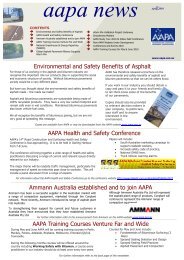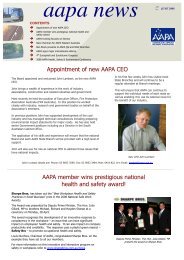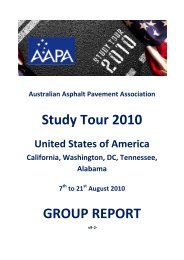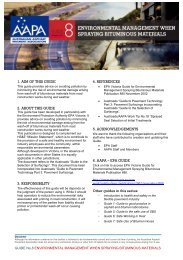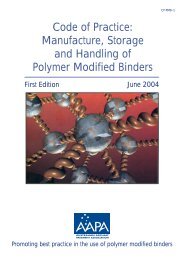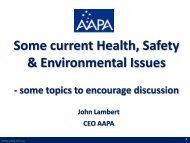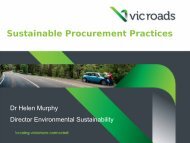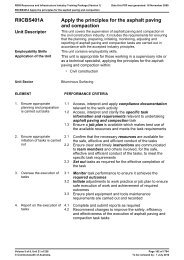Asphalt Review - Volume 32 Number 3 (Jun / Juy 12) - Australian ...
Asphalt Review - Volume 32 Number 3 (Jun / Juy 12) - Australian ...
Asphalt Review - Volume 32 Number 3 (Jun / Juy 12) - Australian ...
Create successful ePaper yourself
Turn your PDF publications into a flip-book with our unique Google optimized e-Paper software.
<strong>Asphalt</strong> reviewTest Track ShowsOutstanding Results forWarm Mix with 50% RAPArticle Courtesy of NCAT. By David H. Timm,Adriana Vargas-Nordcbeck, and J. Richard Willis*Researchers at the National Center for <strong>Asphalt</strong>Technology’s Test Track have observedexcellent results from an experiment pittingconventional pavement mixes against mixescombining recycling and both hot-mix andwarm-mix asphalt.They constructed a control section ofconventional hot mix, an experimental sectionusing hot mix with 50% RAP (reclaimed asphaltpavement), and another section using warm mixfrom a foaming device with 50% RAP. The high-RAP sections had the same total thickness as thecontrol section. In the latest cycle, concludedin September 2011, the high-RAP warm-mixsection performed equal to the control.The attractions of high-RAP and warmmix are compelling for both economicand environmental reasons. Faced withincreasing material prices and trafficdemands, pavement and materials engineersare constantly searching for innovativeapproaches to creating high-performing,long-lasting, and, most critically, economicalpavement structures.Use of RAP has been extensive for thepast 30 years (McNichol, 2005). However,Figure 1. Pavement Materials and Cross Sectionsthe amount of RAP allowed in pavementmixtures has been limited by some statesdue to concerns about the stiffness ofthe aged binder in the RAP and lackof documentation about long-termperformance of high-RAP mixes.Currently, average RAP contents are about18%, with 15 states allowing greater than30% while a few states permit little or no RAPusage (Hansen et al., 2011).Agencies and industry recognize thatincreasing average RAP contents up to 25%could cut life-cycle greenhouse gas emissionsby 10% (NAPA, 2009). In addition, warm-mixasphalt (WMA) has taken the industry by storm;the tonnage produced in the U.S. more thantripled from 2009 to 2010 (Newcomb, 2011).Current estimates are a 20% energyreduction when utilizing WMA duringproduction (NAPA, 2009).Though warm mix and recyclingtechnologies were developed independently,agencies have begun to consider combiningthem to achieve even greater environmental,performance, and cost benefits. NAPA (2009)estimates that 25% RAP combined with WMAcould reduce greenhouse gas emissions by 3million tons per year.Achieving even higher RAP percentagescould have an even greater impact fromsustainability and cost perspectives. Inaddition, the use of WMA technologies canhelp improve workability, which is often anissue for high-RAP mixtures.To explore the use of high RAP and warmmix, these materials became the mainfocus of a group experiment that began in2009 at the Test Track. The experiment wassponsored by the Alabama, Florida, NorthCarolina, South Carolina, and TennesseeDepartments of Transportation and theFederal Highway Administration. The studyconsisted of two sections with 50% RAPthat have endured 10 million standardaxle loadings, with performance equal to acontrol section placed at the same time.Materials andCross SectionsWithin the experiment, there were three testsections, with each section having a surface,intermediate, and base mixture. The firstsection was the control; it did not includeany RAP and the mixtures were producedas conventional hot mixes. The second testsection contained 50% RAP in each layer andthe mixes were produced as hot-mix asphalt(RAP-HMA). The third group used the same50% RAP mixes, but the mixes were producedas WMA using a foaming system (RAP-WMA).The virgin aggregate used in all threesections was a combination of granite andlimestone. Each mixture was designed to 80gyrations following the Superpave procedure.Within the 50% RAP materials, fractionatedRAP was used for the surface (15% fine and35% coarse RAP) and intermediate/basemixtures (20% fine and 30% coarse RAP).Figure 1 illustrates the cross sections andas-built thicknesses with nominal maximumaggregate size (NMAS), virgin PG bindergrade, and mixing temperature noted foreach lift placed. Slight differences in totalROADS JUNE/JULY 20<strong>12</strong> 37



